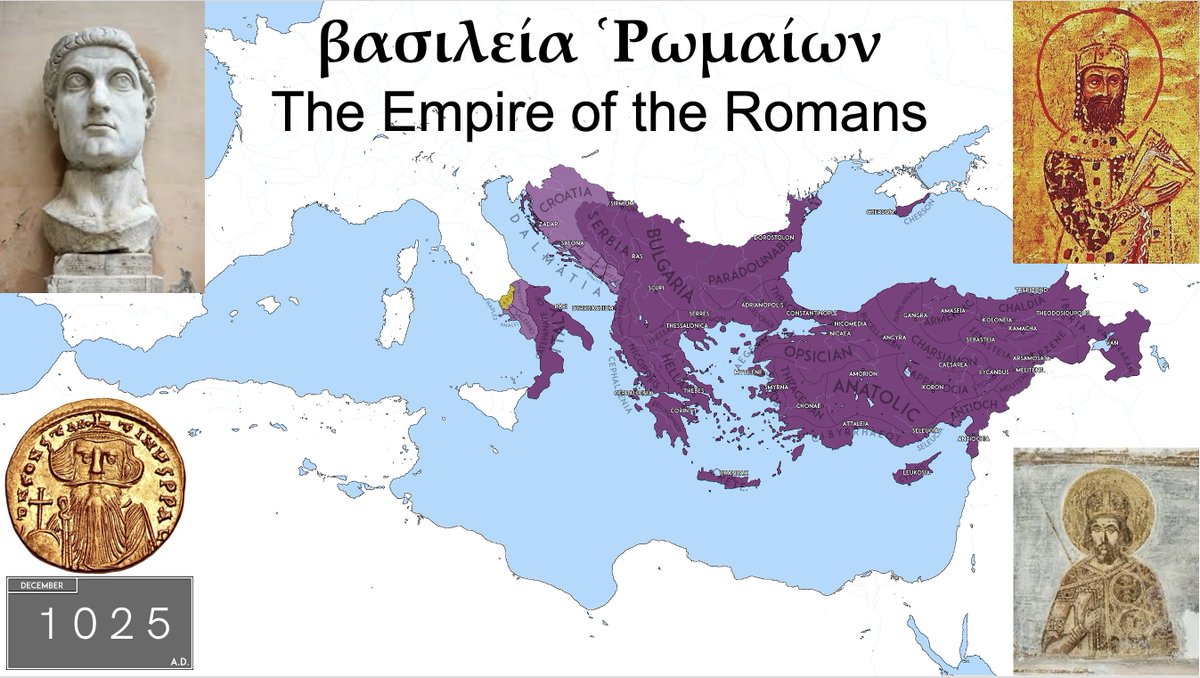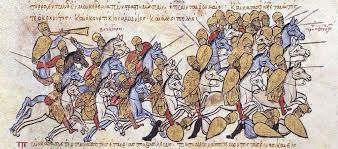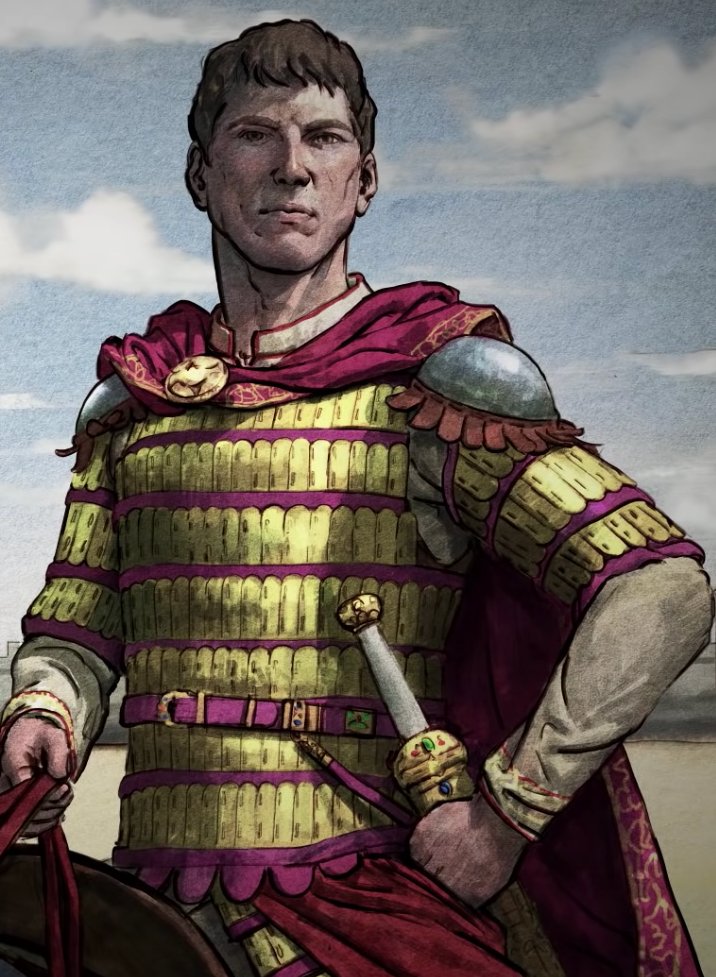
Historian of the Romans (including the Byzantine Empire). Author of Belisarius & Antonina. Professor @iunorthwest. Consulted for @EpicHistoryTV.
4 subscribers
How to get URL link on X (Twitter) App


 The first group of sources demonstrates that emperors and elite historians of the empire itself referred to its peoples as Romans. This is pretty well known, but we’re going back to basics here, so let’s prove it through a variety of examples.
The first group of sources demonstrates that emperors and elite historians of the empire itself referred to its peoples as Romans. This is pretty well known, but we’re going back to basics here, so let’s prove it through a variety of examples. 

 From the moment Enrico Dandolo, the Doge of Venice, proposed that the crusaders should attack the city of Zara, Geoffrey of Villehardouin reports: "There was much opposition."
From the moment Enrico Dandolo, the Doge of Venice, proposed that the crusaders should attack the city of Zara, Geoffrey of Villehardouin reports: "There was much opposition." 

 Geoffrey of Villehardouin (born around 1150) was a French knight and the Marshal of Champagne. He was one of the ambassadors to Venice who negotiated the deal for Venetian shipping of the crusade and he remained with the crusade until the end.
Geoffrey of Villehardouin (born around 1150) was a French knight and the Marshal of Champagne. He was one of the ambassadors to Venice who negotiated the deal for Venetian shipping of the crusade and he remained with the crusade until the end. 

 In addition to posting about my own research, I also occasionally post about the field of Byzantine studies (or as I prefer to think of it, medieval Roman studies) and teaching as a university professor in the USA. Thanks for being here!
In addition to posting about my own research, I also occasionally post about the field of Byzantine studies (or as I prefer to think of it, medieval Roman studies) and teaching as a university professor in the USA. Thanks for being here! 


 Some background: At the command of Justinian (r. 527-565), the general Belisarius led a Roman army to crush the Vandals and restore North Africa and most of its surrounding islands to Roman control in a lightning campaign that lasted just six months (September 533-March 534).
Some background: At the command of Justinian (r. 527-565), the general Belisarius led a Roman army to crush the Vandals and restore North Africa and most of its surrounding islands to Roman control in a lightning campaign that lasted just six months (September 533-March 534). 

 I have been writing on the Comes Stabuli recently and was astonished to learn that occupants of the office included the future emperor Valens (r. 364-378) and the famous generals Stilicho (d. 408) and Aetius (d. 454).
I have been writing on the Comes Stabuli recently and was astonished to learn that occupants of the office included the future emperor Valens (r. 364-378) and the famous generals Stilicho (d. 408) and Aetius (d. 454). 

 I started with places that would let me write a few words about my book to catch the interest of other bibliophiles. The first was on a humble blog called "The Page 99 Test":
I started with places that would let me write a few words about my book to catch the interest of other bibliophiles. The first was on a humble blog called "The Page 99 Test":https://twitter.com/byzantineprof/status/1675950033164976128

 Let's start with the number all modern historians must reckon with. The Roman historian Agathias complains about the army during Justinian's reign: "there should have been a total effective fighting force of 645,000 men, but the number dropped to barely 150,000."
Let's start with the number all modern historians must reckon with. The Roman historian Agathias complains about the army during Justinian's reign: "there should have been a total effective fighting force of 645,000 men, but the number dropped to barely 150,000." 

 First, let's establish a baseline for typical campaign army sizes in the reign of Justinian in the East. For the Battle of Dara in 530, Belisarius commanded 25,000 soldiers. At Satala in 530, Sittas had 15,000. At Callinicum in 531, Belisarius had 20,000.
First, let's establish a baseline for typical campaign army sizes in the reign of Justinian in the East. For the Battle of Dara in 530, Belisarius commanded 25,000 soldiers. At Satala in 530, Sittas had 15,000. At Callinicum in 531, Belisarius had 20,000. 

 While in the Secret History Procopius is very direct about Belisarius’ infatuation with Antonina, he is more reticent about her feelings toward him. Instead, he focuses on Antonina’s supposed power to control Belisarius with spells, suggesting she ensorcelled him into loving her.
While in the Secret History Procopius is very direct about Belisarius’ infatuation with Antonina, he is more reticent about her feelings toward him. Instead, he focuses on Antonina’s supposed power to control Belisarius with spells, suggesting she ensorcelled him into loving her.


 In 627, Heraclius and the Roman army invaded the Persian Empire via Lazica, then marched south across the Zagros to the Great Zab River and won a resounding victory over a Persian army at Nineveh on 12 December.
In 627, Heraclius and the Roman army invaded the Persian Empire via Lazica, then marched south across the Zagros to the Great Zab River and won a resounding victory over a Persian army at Nineveh on 12 December. 

 The Persians had overrun Mesopotamia, Armenia, Syria, Palestine, and Egypt between 604 and 619. It was a tremendous victory. But to hold these lands, the Persians had to balance garrisoning them with troops and also ruling with a light touch so as not to evoke revolt.
The Persians had overrun Mesopotamia, Armenia, Syria, Palestine, and Egypt between 604 and 619. It was a tremendous victory. But to hold these lands, the Persians had to balance garrisoning them with troops and also ruling with a light touch so as not to evoke revolt. 

 Antioch, for example, was in Persian hands for 19 years (610-629), Jerusalem for 15 years (614-629), Alexandria for 10 years (619-629), and the great fortress city of Dara in Mesopotamia for a whopping 25 years (604-629).
Antioch, for example, was in Persian hands for 19 years (610-629), Jerusalem for 15 years (614-629), Alexandria for 10 years (619-629), and the great fortress city of Dara in Mesopotamia for a whopping 25 years (604-629). 


 Early career: Both Belisarius and Sittas were young guardsmen (bucellarii) in the service of Justinian when he was a general in the 520s. They together led a pair of raids into Persian Armenia.
Early career: Both Belisarius and Sittas were young guardsmen (bucellarii) in the service of Justinian when he was a general in the 520s. They together led a pair of raids into Persian Armenia. 

https://twitter.com/MPilekic/status/1685265078684119042Justinian was proud of Belisarius' victories, and was careful to give his general credit - to a point. In all that we know of his celebrations of Belisarius' victories, Justinian was careful to emphasize that Belisarius was subordinate to him. Two examples:


 I have tweeted previously about the details of the battle, so I will just link the old thread here rather than repeating it:
I have tweeted previously about the details of the battle, so I will just link the old thread here rather than repeating it:https://twitter.com/byzantineprof/status/1585617478926958593

 The Tzani lived in northeastern Anatolia, north of Satala (modern Sadak) but south of Trebizond (modern Trabzon), in the Pontic Mountains. Although the Romans had ruled this region in theory since 64, the Tzani remained independent.
The Tzani lived in northeastern Anatolia, north of Satala (modern Sadak) but south of Trebizond (modern Trabzon), in the Pontic Mountains. Although the Romans had ruled this region in theory since 64, the Tzani remained independent. 

 Last week, I tweeted about how a later law reorganizing the civil administration of Armenia prompted a revolt against Roman rule. But in 528, it seems there was no protest against the military reorganization. Why?
Last week, I tweeted about how a later law reorganizing the civil administration of Armenia prompted a revolt against Roman rule. But in 528, it seems there was no protest against the military reorganization. Why?https://twitter.com/byzantineprof/status/1681691831053045760

 This raid is the first introduction in the History of the Wars of Procopius to both Sittas and Belisarius, who would go on to become Justinian's preeminent generals. Last week I tweeted about the death of Sittas. Now I'd like to look at his earlier career.
This raid is the first introduction in the History of the Wars of Procopius to both Sittas and Belisarius, who would go on to become Justinian's preeminent generals. Last week I tweeted about the death of Sittas. Now I'd like to look at his earlier career.

 My most recent publication is my brand new book, #BelisariusAndAntonina, which analyzes the relationship and careers of this famous sixth-century Roman general and his powerful and capable wife.
My most recent publication is my brand new book, #BelisariusAndAntonina, which analyzes the relationship and careers of this famous sixth-century Roman general and his powerful and capable wife.
 After killing Sittas and defeating the Romans at the Battle of Oinochalakon, Artabanes and the Armenian rebels withdrew to Persian Armenia. He defected to the Persians, and remained in Persian service for about five years. But in 545, he defected back to the Romans.
After killing Sittas and defeating the Romans at the Battle of Oinochalakon, Artabanes and the Armenian rebels withdrew to Persian Armenia. He defected to the Persians, and remained in Persian service for about five years. But in 545, he defected back to the Romans. 